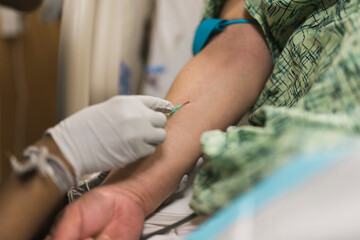
Skin Antisepsis: A Critical Step in Peripheral IV Therapy
Before a single drop of medication is infused or a catheter is threaded into a vein, one of the most important steps in preventing infection occurs—skin antisepsis. Vascular access site preparation may seem like a routine part of IV therapy, but following best practices for skin disinfection is essential for patient safety.
The Infusion Therapy Standards of Practice (9th Edition) by the Infusion Nurses Society (INS) outlines specific evidence-based recommendations in Standard 31: Vascular Access Site Preparation and Skin Antisepsis. These standards guide clinicians in reducing the risk of catheter-related bloodstream infections (CRBSIs) and ensuring the best outcomes for patients.
Best Practices for Skin Preparation Before Peripheral IV Insertion
Here are key recommendations from Standard 31 that clinicians must follow:
1. Use an Appropriate Antiseptic Agent
- For peripheral IV insertion, the preferred antiseptic is >0.5% chlorhexidine gluconate (CHG) in alcohol.
- If CHG is contraindicated (e.g., in infants under 2 months or patients with known sensitivity), povidone-iodine or 70% isopropyl alcohol may be used as alternatives.
2. Application Technique Matters
- The antiseptic should be applied using gentle friction in a back-and-forth motion for at least 30 seconds.
- Let the solution air dry completely—do not blot or blow on the site. This drying process is crucial for maximum antimicrobial effect.
3. Do Not Touch the Site After Prep
- Once the site is prepped and dried, it should remain untouched before catheter insertion.
- If the site is inadvertently touched, it must be re-prepped with a new antiseptic application.
4. Consider Hair Removal if Needed
- Hair removal is only necessary if hair interferes with catheter placement or adhesion of the dressing.
- If required, use clippers, not razors, to reduce skin trauma and infection risk.
5. Skin Integrity Assessment
-
Always assess the site for rashes, wounds, or signs of infection. Avoid compromised skin sites when selecting an insertion location.
Why Skin Antisepsis Matters
The skin is a major reservoir for microorganisms. Even healthy, intact skin contains bacteria that can migrate along the catheter and enter the bloodstream. Inadequate antisepsis can lead to local site infections, phlebitis, and serious complications like sepsis.
By following these evidence-based practices, nurses can dramatically reduce these risks and support better patient outcomes.
Continue Your Education with Pedagogy
For nurses looking to deepen their knowledge and stay compliant with current infusion standards, Pedagogy Continuing Nurse Education offers a comprehensive online course:
👉 Basics of Peripheral IV Therapy: Current Standards of Practice
This course provides foundational and up-to-date training on peripheral IV therapy—including vascular access selection, site preparation, insertion techniques, complication prevention, and documentation. It’s ideal for new nurses, LPNs seeking certification, and seasoned professionals needing a refresher in evidence-based practice.
Invest in safety. Empower your practice. Learn the standards that protect your patients and your license.
References:
- Gorski, L.A., Hadaway, L., Hagle, M.E., McGoldrick, M., Orr, M., & Doellman, D. (2024). Infusion therapy standards of practice. Journal of Infusion Nursing, 47(1S), S1–S224.
- Centers for Disease Control and Prevention (CDC). Guidelines for the Prevention of Intravascular Catheter-Related Infections.

